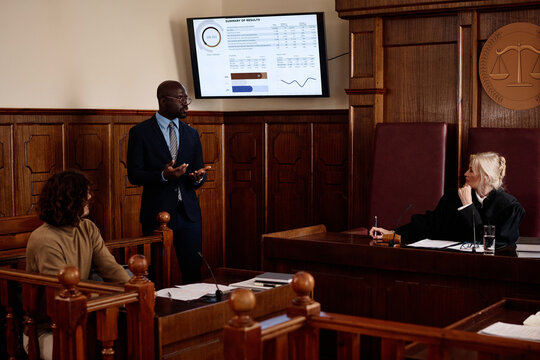Grasping the Art of Trial Presentations: Key Approaches for Effective Legal Arguments
Navigating the Complexities of Trial Presentations: Tips for Seamless Shipment and Compelling Arguments
In the realm of legal proceedings, the art of trial presentation stands as a vital determinant of success. The complexities intrinsic in test presentations need a fragile balance of finesse, method, and ability.

Understanding Test Purposes
To effectively navigate a test, it is crucial to have a clear understanding of the goals that need to be accomplished. Prior to tipping right into the court room, legal teams must define their goals and desired outcomes. These goals work as assisting concepts throughout the trial, shaping methods and affecting decision-making procedures.
Comprehending trial goals includes an extensive analysis of the situation, legal criteria, and the client's benefits. Trial Presentations. It requires a meticulous examination of the facts, identifying key concerns, and preparing for possible obstacles. By establishing particular and measurable objectives, attorneys can tailor their arguments and discussions to align with the desired outcomes
Additionally, a clear understanding of trial purposes allows legal groups to focus on evidence, witnesses, and lawful disagreements efficiently. It enables the development of a coherent story that resonates with the discretionary, strengthening the total case discussion.

Organizing Proof Properly
Having a clear understanding of test goals lays the foundation for arranging evidence effectively in lawful procedures - Trial Presentations. By aligning the discussion of proof with the desired end results of the test, legal groups can enhance their arguments and boost their persuasiveness. One vital aspect of arranging evidence is categorization. Organizing evidence based upon styles or relevance to certain legal components can assist streamline the discussion and make complex details much more digestible for the court or jury.
An additional secret element in organizing proof efficiently is developing a sensible circulation. Presenting proof in a systematic and consecutive manner can assist build an engaging story that supports the legal arguments being made. Furthermore, making use of aesthetic help such as charts, charts, or timelines can additionally boost the organization of evidence and help in making clear intricate relationships or sequences of occasions.
In addition, ensuring that all evidence provided is relevant and acceptable to the instance is essential. Inadmissible or pointless proof can diminish the toughness of the debate and possibly harm the reliability of today celebration. A careful evaluation and choice process ought to be carried out to include just the most lawfully sound and impactful evidence in the trial discussion.
Crafting Influential Stories
Crafting engaging narratives plays an essential role in offering convincing debates during lawful proceedings. When creating a narrative for a test presentation, it is necessary to establish a clear storyline that highlights vital points and attaches them in a coherent fashion. By weaving together evidence, testament, and Full Report legal disagreements right into a persuasive and cohesive story, legal experts can successfully advocate for their clients and boost the likelihood of a positive end result in the courtroom.
Grasping Aesthetic Help
Efficient use of aesthetic help is vital to enhancing the effect and clearness of test discussions. Visual aids, when used purposefully, have the power to simplify complex info, strengthen vital factors, and leave a lasting perception on the discretionary. To understand aesthetic help click to read in test presentations, it is important to make sure that they are clear, succinct, and pertinent to the debates being made.
When incorporating visual aids, such as charts, graphs, photographs, or timelines, into a trial presentation, it is vital to keep them visually appealing yet professional. The visuals should complement the spoken debates, giving a graph of the details being gone over without frustrating the audience with unnecessary details.
Moreover, practicing with the aesthetic help in advance is critical to ensure a smooth distribution during the trial. Familiarizing oneself with the web content, shifts, and timings of each visual aid can aid keep the flow of the presentation and protect against technological glitches that may arise.
Supplying Impactful Closing Disagreements
A compelling closing disagreement offers as the culmination of check over here a test presentation, enveloping the core narrative and convincing the court and jury towards a desirable decision. Begin by laying out the primary debates that support your client's placement, emphasizing why the proof offered throughout the trial sustains your narrative.
Additionally, including sob story can better strengthen your closing disagreement. By humanizing the instance and connecting on an individual level with the decision-makers, you can stimulate compassion and understanding, affecting their assumption of the facts provided. Furthermore, stating the legal requirements that need to be met for a favorable ruling can strengthen the legitimacy of your placement. Inevitably, a well-crafted closing argument ought to leave a long lasting perception, engaging the discretionary to regulation in your customer's support.
Conclusion
Finally, mastering trial discussions entails recognizing purposes, arranging proof, crafting narratives, utilizing visual help, and supplying impactful closing debates. By carrying out these methods successfully, attorneys can provide their case seamlessly and make engaging debates in the court. It is important to navigate the complexities of test presentations with precision and ability to attain success in legal proceedings.
By straightening the discussion of evidence with the desired end results of the test, legal groups can enhance their arguments and boost their persuasiveness (Trial Presentations). To understand visual help in test presentations, it is critical to make sure that they are clear, concise, and relevant to the debates being made
A compelling closing debate offers as the culmination of a test presentation, enveloping the core story and encouraging the judge and court in the direction of a positive choice. Begin by outlining the primary arguments that sustain your client's placement, emphasizing why the proof provided throughout the test supports your story.In conclusion, understanding trial discussions involves comprehending objectives, arranging proof, crafting narratives, making use of visual help, and delivering impactful closing disagreements.